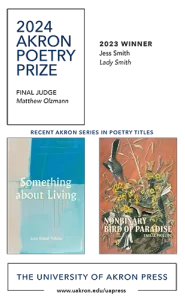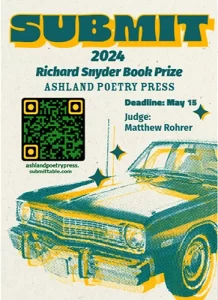The Carolina Quarterly – Winter/Spring 2011
Volume 61 Number 1
Winter/Spring 2011
Triannual
Sarah Gorman
“Will you still need me, will you still feed me, when I’m sixty-four?” As the venerable Carolina Quarterly enters its 64th year of publication in 2012, the answer from discerning readers, and good writers, must be yes. Poetry, fiction, essays, reviews, and graphic art accepted by the CQ’s editors provide a select tour through recent works of both polished and emerging writers and artists. Thematically, this issue features that which is certain—death and Texas.
“Will you still need me, will you still feed me, when I’m sixty-four?” As the venerable Carolina Quarterly enters its 64th year of publication in 2012, the answer from discerning readers, and good writers, must be yes. Poetry, fiction, essays, reviews, and graphic art accepted by the CQ’s editors provide a select tour through recent works of both polished and emerging writers and artists. Thematically, this issue features that which is certain—death and Texas.
George Singleton’s “Fresh Meat on Wheels” demonstrates the talent that led to the author’s receipt of a Guggenheim fellowship in 2009 and recognition from the Fellowship of Southern Writers in 2011. This incisive yet loving sendup of the best and worst of traditional southern culture, as revealed through the doings at a sixth-grade sleepover, would have pleased H.L. Mencken. Singleton, though, earns his effect from a kinder wit than that which coruscates Mencken’s accounts of southern life. Implying rather than exposing its mechanics, this delightful work rewards multiple readings. It’s laugh-out-loud funny, poignant, and satisfying.
A newer talent which does reveal the scaffolding of the writing process is that of Pamela DiFrancesco in “The Chuck Berry Tape Massacre.” The account of mother love swamped by mental illness, child neglect, singing, and rock ‘n’ roll unfolds through discrete scenes that the reader pieces together only gradually. Despite surreal juxtapositions, jerky movement, and painful scenes, DiFrancesco finally bestows on her characters redemption and even immortality. She communicates the tragedy of human suffering, whereas Singleton’s detachment conveys its absurdity.
A review of Stanley Fish’s How to Write a Sentence by CQ’s intern Jonathan Pattishall proves that a student may write incisively about the work of an eminent scholar. The review calls attention to a book that would likely repay the attention of lovers of good writing, and also demonstrates that the reviewer himself is no slouch when it comes to writing a sentence.
Of the eleven poets represented in this issue, Nancy Carol Moody is notable for her imagistic “When They Ask About My Face”: she uses “autumns” as a verb, and candidly likens the texture of her complexion to that of “a peppermint held / too long against the palate.” Zachary Vernon embeds three poems by Wilmer Mills into the account of a telephone interview Vernon conducted with him, a particularly satisfying way to be introduced to a poet. Mills could be identified as formalist, pastoral, agrarian, and even mystical, but Vernon takes pains to avoid reductionism in his observations about Mills’s work. In “Telos,” Mills counsels coolness in the face of the certainty of death: “Man, even pills expire. / So why not shelve / The matter of impending human doom.” Instead, “Let breathing be a comfort to you there. / Delight in the softness of your eyebrow hair.”
Austin, Texas photographer Amanda Mullee’s work is represented with nine images. Mullee works “in the tradition of documentary photography,” seeking “to capture a sense of mystery in the seemingly ordinary moments of life” (an apt characterization of this issue of CQ). Her cover photo of an impassive teenager meeting the viewer’s eyes through the open window of a driver’s side car door seems ordinary, until one checks the title: “Chandelier.” A closer look at the photo reveals a medium-sized crystal chandelier suspended from the car’s ceiling.
Among the nonfiction works, one strong piece could be read as flash fiction: Janis Butler Holm’s “Ripple Effect.” In ninety words, she made me smile and tore my heart out. Thomas Horan’s “Eat the Cake” starts as a stream-of-consciousness recollection of cakes he has known, but develops seamlessly into reflections about the deaths of his Uncle Billy, a wonderful bulimic baker named Constance, and his father. Horan concludes with the prophecy that, at the time of his own death, he won’t be thanking God he “didn’t eat that last piece of armadillo cake.” Instead, he will be reminiscing “through a nurse-induced opioid coma, about the pieces of cake I did eat.”
New Orleans native Sybil Kein, interviewed in late 2010, wrote the only book ever published in Louisiana Creole, Gumbo People, in 1999. A musician and scholar, she was honored by the Sorbonne for her scholarship on Creole culture. Like Native American children, Kein was punished by both teachers and family for speaking Creole, her first language, in school. She grew up practicing both Catholicism and Voodoo. “It was like having an extra set of prayers and an extra set of rules” for good living. Voodoo, she says, originated the saying “What goes around, comes around.”
This issue of Carolina Quarterly repays many-fold the time invested in reading. Production values are high, editing is impeccable, the content blends variety with quality, and it even feels good in the hand. Chapel Hill scholars are indeed fortunate that, as the back cover states, the publication is “Free to UNC Students.”
[www.thecarolinaquarterly.com]




